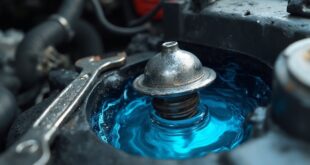If your car has no electrical power at all, it's often due to a dead battery, a blown main fuse, or loose battery cables. A failing ignition switch can also cause complete power loss. You might notice dim headlights or dashboard lights not working. Check for tight and clean connections, and inspect your fuses. If you're unsure, there are ways to troubleshoot these issues further to get your car up and running again.
Common Causes of Electrical Power Loss
When you're experiencing electrical power loss in your vehicle, it often stems from a few common culprits.
A dead car battery is a primary suspect, especially if it's older than three to five years. You might also discover a blown main fuse, which can cut off power entirely.
Loose battery cables can disrupt the current flow, so check those connections. If the ignition switch is failing, it may prevent power from reaching your accessories.
Finally, a malfunctioning alternator can drain your battery, leaving you in the dark. Identifying these issues early can save you time and money.
Recognizing Signs of a Dead Car Battery
How can you tell if your car battery is on its last legs? You might notice a few telltale signs. Pay attention to dim headlights, a slow engine crank, or dashboard warning lights. Your electrical accessories may also malfunction, indicating trouble.
| Sign | What It Means |
|---|---|
| Dim headlights | Weak battery power |
| Slow engine crank | Insufficient power |
| Dashboard lights | Potential battery failure |
| Malfunctioning accessories | Battery issues present |
If you experience these symptoms, it's time to check or replace your battery before you get stranded.
The Impact of a Blown Main Fuse
A blown main fuse can greatly disrupt your vehicle's electrical system, leaving you with little to no power. This fuse controls essential components, including the battery and ignition system.
When it blows, you may experience complete electrical failure, making your car unresponsive. You might notice dashboard lights flickering or not working at all.
Fortunately, checking and replacing a blown fuse is typically straightforward and inexpensive, often costing around $25. Using a multimeter, you can quickly determine if the fuse is the culprit, allowing you to restore power and get back on the road without much hassle.
Importance of Battery Connection Integrity
After addressing the potential issues caused by a blown main fuse, it's important to contemplate the integrity of your battery connections.
Loose or corroded battery cables can disrupt the flow of electricity, leaving you with no power at all. Regularly check your connections for tightness and signs of corrosion, as even a small amount of rust can hinder performance.
If you notice any issues, clean the connections or tighten them as necessary. Ensuring strong battery connection integrity is essential for your vehicle's electrical system to function properly and can save you from unexpected breakdowns.
Diagnosing a Failing Ignition Switch
When your car struggles to start or electrical accessories fail to power up, it could signal a problem with the ignition switch.
To diagnose this issue, look for these signs:
- No dashboard lights when turning the key
- Accessories not functioning or sporadically working
- Starter motor not engaging at all
- Burning smell or visible damage around the ignition area
If you notice any of these symptoms, it's time to inspect the ignition switch.
Checking for burnt or broken wires can save you time and hassle. If you're unsure, don't hesitate to consult a mechanic for assistance.
Understanding Alternator Functionality
If your ignition switch is functioning properly but you're still experiencing electrical issues, the alternator might be the culprit.
The alternator's primary job is to charge your battery while the engine runs. If it's failing, it can't generate enough power, leaving your battery drained. This can lead to dimming lights, malfunctioning accessories, or even a complete power loss.
Regularly checking the alternator's output with a multimeter can help you catch issues early. Remember, a well-functioning alternator is essential for maintaining electrical power in your car and ensuring that all components operate smoothly.
Don't ignore signs of alternator trouble!
Troubleshooting Steps for Restoring Power
To restore power to your vehicle, start by checking the battery and its connections, since a weak or loose battery can be the root of your electrical issues.
Follow these troubleshooting steps:
- Inspect battery cables for corrosion or looseness.
- Use a multimeter to check the battery voltage; it should be 12.6V or higher.
- Look for blown fuses and replace them as needed.
- Test the ignition switch functionality to verify it's working properly.
If you still encounter issues, it's time to contact a mechanic for further diagnosis and repairs.
Don't hesitate to seek professional help!
Frequently Asked Questions
Can Extreme Weather Affect My Car's Electrical System?
Extreme weather can greatly affect your car's electrical system. Cold temperatures may reduce battery efficiency, while excessive heat can lead to battery damage. Regular maintenance helps mitigate these effects and keeps your vehicle running smoothly.
How Do I Know if My Battery Needs Replacement?
To know if your battery needs replacement, look for signs like slow engine cranks, dim headlights, or corrosion on terminals. If it's over three years old, consider testing or replacing it for reliability.
Is It Safe to Jump-Start a Car With a Dead Battery?
Yes, it's generally safe to jump-start a car with a dead battery, but make certain you follow proper procedures. Always connect the cables correctly and wear safety gear to protect yourself from potential hazards.
What Tools Do I Need for Electrical Troubleshooting?
For electrical troubleshooting, you'll need a multimeter to check voltage, a wrench for tightening connections, insulated tools for safety, and possibly a fuse tester. Don't forget safety goggles to protect your eyes during inspections.
How Can I Prevent Future Electrical Power Loss Issues?
To prevent future electrical power loss issues, regularly check your battery's health, guarantee connections are tight, inspect fuses, and maintain your alternator. Routine maintenance can save you from unexpected breakdowns and costly repairs.
 Car Service Land Coupons for Oil change, Tires, Wheel alignment, Brakes, Maintenance
Car Service Land Coupons for Oil change, Tires, Wheel alignment, Brakes, Maintenance




